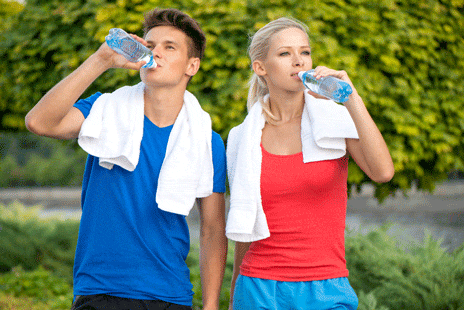Per an updated consensus statement on exercise-associated hyponatremia (EAH), the best approach for hikers, football players, athletes and exercisers is to drink when thirsty. A news release from Wolters Kluwer Health: Lippincott Williams and Wilkins states that doing this could prevent potentially serious reductions in blood sodium levels.
The advisory, which appears in the June issue of the Clinical Journal of Sport Medicine, published by Wolters Kluwer Health, was developed at this year’s 3rd International Exercise-Associated Hyponotremia Consensus Development Conference, according to the release.
The Consensus Panel met to revise previous recommendations after two high school football players died from dilutional EAH last summer—an incident that the release notes was largely preventable.
“Our major goal was to re-educate the public on the hazards of drinking beyond thirst during exercise,” lead author Tamara Hew-Butler, DPM, PhD, of Oakland University, Rochester, Mich, comments in the release.
The release explains that the updated statement emphasizes a more balanced approach to hydration—especially during the summer months, when exercising in the heat increases the risk for developing dangerously low blood sodium levels associated with overdrinking.
The statement also emphasizes that healthcare professionals should guide their EAH treatment by the severity of symptoms, not just the individual’s sodium level. As well, it highlights the need for athletes and support teams to educate themselves on measures to reduce excessive fluid intake, per the release.
EAH, sometimes called “water intoxication,” refers to the reductions in the body’s sodium level occurring during or up to 24 hours after physical activity. There could be no or only mild symptoms, the release explains.
When symptoms occur, they typically include headache, vomiting, and confusion or seizures, resulting from swelling of the brain (cerebral edema). Without immediate treatment, severe EAH can be rapidly fatal, the release notes.
Sustained, excessive intake of water, sports drinks, or other fluids that exceed the body’s ability to eliminate fluids in the form of sweat and urine is the major risk factor for EAH, the release indicates. The excess fluid dilutes the body’s sodium level, interfering with normal regulatory processes.
Since drinking too much is the main cause of EAH, the most effective prevention is to drink less. “The safest individualized hydration strategy before, during, and immediately following exercise is to drink palatable fluids when thirsty,” according to the Consensus Panel, in the release.
Some athletes may drink too much because they have heard advice to “drink before they get thirsty” in order to avoid dehydration, the release states. The authors note in the release that drinking when thirsty will not only prevent EAH, but will also prevent possible drops in performance due to dehydration.
Hew-Butler adds in the release that athletes and coaches must recognize the need for balanced hydration before, during, and immediately following exercise to prevent further morbidity and mortality associated with “forced hydration” practices.
“Every single EAH death is tragic and preventable, if we just listen to our bodies and let go of the pervasive advice that if a little is good, than more must be better,” she states in the release.
[Source(s): Wolters Kluwer Health: Lippincott Williams and Wilkins, Newswise]





